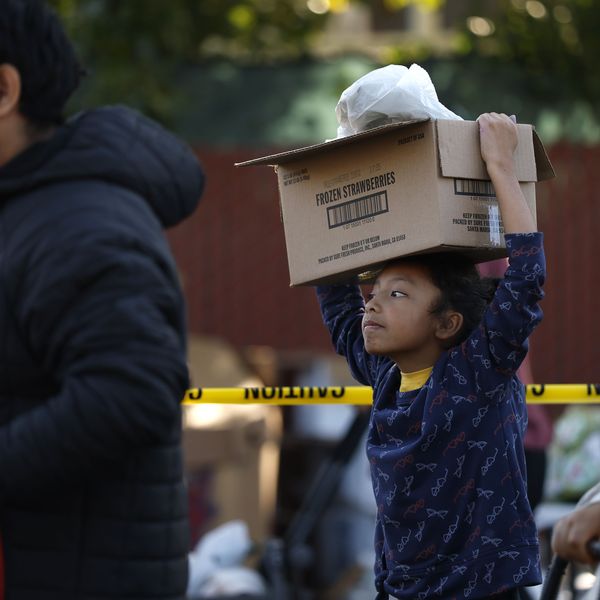What Recovery? Report Reveals Rising Poverty for Children in America
Annie E. Casey Foundation study finds recovery from Great Recession has left out children of color altogether
There are roughly three million more U.S. children living in poverty today than during the outbreak of the Great Recession in 2008, and the so-called economic recovery has bypassed children of color altogether, a harrowing new report reveals.
The 2015 Data Book, released Tuesday by the Baltimore-based Annie E. Casey Foundation, evaluates information from numerous federal agencies from 2008 to 2013 to determine child well-being nationwide.
The report finds that approximately 22 percent of U.S. children were beneath the poverty line in 2013, a significant increase from 18 percent in 2008. Moreover, 31 percent of children in 2013 had parents without secure employment, compared to 27 percent in 2008.
The data showed that, for many, there has been no economic recession at all.
"Although we are several years past the end of the recession, millions of families still have not benefited from the economic recovery," said Patrick McCarthy, president and CEO of the Casey Foundation, in a press statement. "While we've seen an increase in employment in recent years, many of these jobs are low-wage and cannot support even basic family expenses."
These trends affect communities of color even more severely than the general population.
"Race is one of the strongest factor's influencing a child's economic stability," notes a summary of the study's findings. For example, African-American children are two times as likely to live in high-poverty neighborhoods, and African-American communities overall are hit hardest by unemployment.
Researchers note that, throughout the recovery, racial inequality in America is deepening. According to Laura Speer, associate director for policy reform and advocacy: "Today, as the economy recovers, we see a widening gap between the living standards of many children of color and other kids."
Tuesday's study follows other research which finds that racial segregation is worsening across the country. A Cornell University analysis released in May revealed that the foreclosure crisis between 2005 and 2009 disproportionately displaced black and Latino households and led to a spike in racial segregation across the country.
An Urgent Message From Our Co-Founder
Dear Common Dreams reader, The U.S. is on a fast track to authoritarianism like nothing I've ever seen. Meanwhile, corporate news outlets are utterly capitulating to Trump, twisting their coverage to avoid drawing his ire while lining up to stuff cash in his pockets. That's why I believe that Common Dreams is doing the best and most consequential reporting that we've ever done. Our small but mighty team is a progressive reporting powerhouse, covering the news every day that the corporate media never will. Our mission has always been simple: To inform. To inspire. And to ignite change for the common good. Now here's the key piece that I want all our readers to understand: None of this would be possible without your financial support. That's not just some fundraising cliche. It's the absolute and literal truth. We don't accept corporate advertising and never will. We don't have a paywall because we don't think people should be blocked from critical news based on their ability to pay. Everything we do is funded by the donations of readers like you. Will you donate now to help power the nonprofit, independent reporting of Common Dreams? Thank you for being a vital member of our community. Together, we can keep independent journalism alive when it’s needed most. - Craig Brown, Co-founder |
There are roughly three million more U.S. children living in poverty today than during the outbreak of the Great Recession in 2008, and the so-called economic recovery has bypassed children of color altogether, a harrowing new report reveals.
The 2015 Data Book, released Tuesday by the Baltimore-based Annie E. Casey Foundation, evaluates information from numerous federal agencies from 2008 to 2013 to determine child well-being nationwide.
The report finds that approximately 22 percent of U.S. children were beneath the poverty line in 2013, a significant increase from 18 percent in 2008. Moreover, 31 percent of children in 2013 had parents without secure employment, compared to 27 percent in 2008.
The data showed that, for many, there has been no economic recession at all.
"Although we are several years past the end of the recession, millions of families still have not benefited from the economic recovery," said Patrick McCarthy, president and CEO of the Casey Foundation, in a press statement. "While we've seen an increase in employment in recent years, many of these jobs are low-wage and cannot support even basic family expenses."
These trends affect communities of color even more severely than the general population.
"Race is one of the strongest factor's influencing a child's economic stability," notes a summary of the study's findings. For example, African-American children are two times as likely to live in high-poverty neighborhoods, and African-American communities overall are hit hardest by unemployment.
Researchers note that, throughout the recovery, racial inequality in America is deepening. According to Laura Speer, associate director for policy reform and advocacy: "Today, as the economy recovers, we see a widening gap between the living standards of many children of color and other kids."
Tuesday's study follows other research which finds that racial segregation is worsening across the country. A Cornell University analysis released in May revealed that the foreclosure crisis between 2005 and 2009 disproportionately displaced black and Latino households and led to a spike in racial segregation across the country.
There are roughly three million more U.S. children living in poverty today than during the outbreak of the Great Recession in 2008, and the so-called economic recovery has bypassed children of color altogether, a harrowing new report reveals.
The 2015 Data Book, released Tuesday by the Baltimore-based Annie E. Casey Foundation, evaluates information from numerous federal agencies from 2008 to 2013 to determine child well-being nationwide.
The report finds that approximately 22 percent of U.S. children were beneath the poverty line in 2013, a significant increase from 18 percent in 2008. Moreover, 31 percent of children in 2013 had parents without secure employment, compared to 27 percent in 2008.
The data showed that, for many, there has been no economic recession at all.
"Although we are several years past the end of the recession, millions of families still have not benefited from the economic recovery," said Patrick McCarthy, president and CEO of the Casey Foundation, in a press statement. "While we've seen an increase in employment in recent years, many of these jobs are low-wage and cannot support even basic family expenses."
These trends affect communities of color even more severely than the general population.
"Race is one of the strongest factor's influencing a child's economic stability," notes a summary of the study's findings. For example, African-American children are two times as likely to live in high-poverty neighborhoods, and African-American communities overall are hit hardest by unemployment.
Researchers note that, throughout the recovery, racial inequality in America is deepening. According to Laura Speer, associate director for policy reform and advocacy: "Today, as the economy recovers, we see a widening gap between the living standards of many children of color and other kids."
Tuesday's study follows other research which finds that racial segregation is worsening across the country. A Cornell University analysis released in May revealed that the foreclosure crisis between 2005 and 2009 disproportionately displaced black and Latino households and led to a spike in racial segregation across the country.

